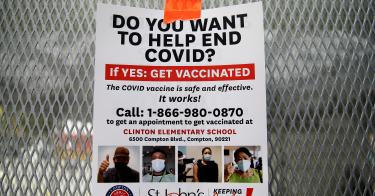One-third of Republican respondents told pollsters earlier this month that they don’t plan to get COVID-19 shots. Another 20% said they haven’t yet made up their minds.
While public health officials have been worried about vaccine skepticism among minorities, the poll’s responses diverged much more by political affiliation than by race.
To understand why many politically moderate to conservative Americans seem disinclined to get vaccinated, GOP pollster Frank Luntz recently convened a focus group of “vaccine-hesitant Trump voters.” What he heard, as reported by The Washington Post, was illuminating.
By the end of the session, all the participants said they were now more likely to get immunized.
One participant’s comment crystallized the key lesson from the two-hour exercise: “We want to be educated, not indoctrinated.”
>>> All Signs Point to Vaccine Success Against COVID-19
What changed their minds had nothing to do with politics. Participants said that an appeal from former President Donald Trump wouldn’t persuade them to get a shot. Nor did messages they viewed from various congressional Republicans. A pro-vaccine public service announcement produced by Fox News fell flat. So did a PSA featuring former Presidents Barack Obama, George W. Bush, Bill Clinton and Jimmy Carter.
Participants found the voice of government authority similarly unpersuasive. A pharmacist who formerly worked at Merck, a company helping to produce vaccines, said: “I know their vaccines are good products. I trust them. What I don’t trust is the government telling me what I need to do when they haven’t led us down the right road.”
So what made these Trump supporters shift their views on vaccines? Science—offered straight-up and with a dash of humility.
The unlikely change agent was Dr. Tom Frieden, who headed the Centers for Disease Control and Prevention during the Obama administration. Frieden appealed to facts, not his credentials. He noted that the theory behind the vaccine was backed by 20 years of research, that tens of thousands of people had participated in well-controlled clinical trials, and that the overwhelming share of doctors have opted for the shots.
He leavened those facts with an acknowledgment of uncertainty. He conceded that the vaccine's potential long-term risks were unknown. He pointed out that the virus's long-term effects were also uncertain.
“He’s just honest with us and telling us nothing is 100% here, people,” one participant noted.
Contrast that with what we’ve heard from the CDC, which has too often professed to know things with certainty, only to be later proven wrong.
Until March 19, for example, CDC recommended that students be kept 6 feet apart in classrooms. The agency’s “science brief” on the subject says that its “recommendation for six feet of physical distancing is based on historical studies of other contagious diseases.”
But the CDC brief does not cite a single classroom study supporting the 6-foot separation. The only classroom-based study it cites for that standard examined a 1982 meningitis outbreak in an elementary school. According to CDC, that study found that the “carriage rate was higher for students in a classroom with chairs spaced less than 40 inches (3.33 feet) apart”—not 6 feet.
The findings of that study, and a long list of others, are consistent with recommendations from the World Health Organization and the American Academy of Pediatrics that schoolchildren maintain a distance of 1 meter (3.28 feet).
CDC has nevertheless complicated school reopenings by recommending—until quite recently—that schools place desks at least 6 feet apart.
>>> A Statistical Analysis of COVID-19 and Government Protection Measures in the U.S.
As Dr. Ashish Jha, Dean of the Brown University School of Public Health, told The New York Times, “Six feet doesn’t protect teachers, but it does keep kids out of school.”
Although millions may uncritically accept CDC’s recommendations, it’s no wonder that millions more do not. It’s not that they are “anti-science,” it’s that they don’t just blindly accept whatever they’re being told by “experts” and government officials. They want to base decisions about their health on reliable information honestly presented, understanding that every option comes with a degree of uncertainty.
In that sense, vaccine hesitancy among Republicans doesn’t look all that different from vaccine hesitancy among minorities.
“I’ve been thinking the messaging was going to be very different for communities of color, for Democrats, for Republicans,” Natalie Davis, a co-founder of the left-leaning United States of Care, told The Washington Post. “But it feels like it comes down to the basics that are shared across populations. People want full, accurate information so they can decide if this is the right thing for them and their loved ones.”
It’s a sobering message for many in the expert class, whose hectoring on everything from COVID-19 to climate change rests on asserting their authority and demanding acquiescence. It turns out, people are more receptive to education than indoctrination.
This piece originally appeared in The Sacramento Bee




